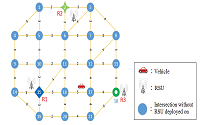Efficient RSU Selection Approaches for Load Balancing in Vehicular Ad Hoc Networks
DOI:
https://doi.org/10.46604/aiti.2020.4080Keywords:
VANET, RSU, load balance, routingAbstract
Due to advances in wireless communication technologies, wireless transmissions gradually replace traditional wired data transmissions. In recent years, vehicles on the move can also enjoy the convenience of wireless communication technologies by assisting each other in message exchange and form an interconnecting network, namely Vehicular Ad Hoc Networks (VANETs). In a VANET, each vehicle is capable of communicating with nearby vehicles and accessing information provided by the network. There are two basic communication models in VANETs, V2V and V2I. Vehicles equipped with wireless transceiver can communicate with other vehicles (V2V) or roadside units (RSUs) (V2I). RSUs acting as gateways are entry points to the Internet for vehicles. Naturally, vehicles tend to choose nearby RSUs as serving gateways. However, due to uneven density distribution and high mobility nature of vehicles, load imbalance of RSUs can happen. In this paper, we study the RSU load-balancing problem and propose two solutions. In the first solution, the whole network is divided into sub-regions based on RSUs’ locations. A RSU provides Internet access for vehicles in its sub-region and the boundaries between sub-regions change dynamically to adopt to load migration. In the second solution, vehicles choose their serving RSUs distributedly by taking their future trajectories and RSUs’ loading information into considerations. From simulation results, the proposed methods can improve packet delivery ratio, packet delay, and load balance among RSUs.
References
F. Cunha, L. Villas, A. Boukerche, G. Maia, A. Viana, R. A. F. Mini, and A. A. F. Loureiro, “Data communication in VANETs: protocols, applications and challenges,” Ad Hoc Networks, vol. 44, pp. 90-103, July 2016.
M. K. Priyan and G. U. Devi, “A survey on internet of vehicles: applications, technologies, challenges and opportunities,” International Journal of Advanced Intelligence Paradigms, vol. 12, no. 1-2, pp. 98-119, 2019.
C. Englund, L. Chen, A. Vinel, and S. Y. Lin, “Future applications of VANETs,” In Vehicular Ad Hoc Networks; C. Campolo, A. Molinaro, and R. Scopigno, Eds., Springer International Publishing: Switzerland, pp. 525-544, 2015.
H. Zhu, K. V. Yuen, L. Mihaylova, and H. Leung, “Overview of environment perception for intelligent vehicles,” IEEE Transactions on Intelligent Transportation Systems, vol. 18, no. 10, pp. 2584-2601, October 2017.
C. F. Huang and Y. H. Chen, “Message-efficient route planning based on comprehensive real-time traffic map in VANETs”, Proceedings of Engineering and Technology Innovation, vol. 9, pp. 25-31, 2018.
E. Uhlemann, “Introducing connected vehicles,” IEEE Vehicular Technology Magazine, vol. 10, no. 1, pp. 23-31, March 2015.
I. Wahid, A. A. Ikram, M. Ahmad, S. Ali, and A. Ali, “State of the art routing protocols in VANETs: a review,” Procedia Computer Science, vol. 130, pp. 689-694, 2018.
S. Boussoufa-Lahlah, F. Semchedine, and L. Bouallouche-Medjkoune, “Geographic routing protocols for vehicular ad hoc networks (VANETs): a survey,” Vehicular Communications, vol. 11, pp. 20-31, January 2018.
V. Naumov, R. Baumann, and T. Gross, “An evaluation of inter-vehicle ad hoc networks based on realistic vehicular traces,” Proc. of the 7th ACM international symposium on Mobile ad hoc networking and computing, May 2006, pp. 108-119.
V. Naumov and T. Gross, “Connectivity-aware routing (CAR) in vehicular ad-hoc networks,” IEEE INFOCOM 2007-26th IEEE International Conference on Computer Communications, 2007, pp. 1919-1927.
M. Jerbi, S. M. Seouci, R. Meraihi, and Y. Ghamri-Doudane, “An improved vehicular ad hoc routing protocol for city environments,” IEEE International Conference on Communications, May 2007, pp. 3972-3979.
P. Prithviraj and G. Aniruddha, “Maximizing vehicular network connectivity through an effective placement of road side units using voronoi diagrams,” IEEE 13th International Conference on Mobile Data Management, July 2012, pp. 274-275.
U. F. Mohd and P. Mohammed, “Integration of vehicular roadside access and the internet: challenges & a review of strategies,” IEEE 2012 International Conference on Devices, Circuits and Systems, March 2012, pp. 568-571.
G. N. Alia, P. H. J. Chong, S. K. Samantha, and E. Chan, “Efficient data dissemination in cooperative multi-RSU vehicular ad hoc networks (VANETs),” Journal of Systems and Software, vol. 117, pp. 508-527, July 2016.
Y. Dai, D. Xu, S. Maharjan, and Y. Zhang, “Joint load balancing and offloading in vehicular edge computing and networks,” IEEE Internet of Things Journal (Early Access), vol. 6, no. 3, pp. 4377-4387, June 2019.
Y. Bejerano and S. J. Han, “Cell breathing techniques for load balancing in wireless LANs,” IEEE Transactions on Mobile Computing, vol. 8, no. 6, pp. 735-749, June 2009.
F. Aurenhammer, “Voronoi diagrams: a survey of a fundamental geometric data structure,” ACM Computing Survey, vol. 23, no. 3, pp. 345-405, September 1991.

Published
How to Cite
Issue
Section
License
Submission of a manuscript implies: that the work described has not been published before that it is not under consideration for publication elsewhere; that if and when the manuscript is accepted for publication. Authors can retain copyright in their articles with no restrictions. is accepted for publication. Authors can retain copyright of their article with no restrictions.
Since Jan. 01, 2019, AITI will publish new articles with Creative Commons Attribution Non-Commercial License, under The Creative Commons Attribution Non-Commercial 4.0 International (CC BY-NC 4.0) License.
The Creative Commons Attribution Non-Commercial (CC-BY-NC) License permits use, distribution and reproduction in any medium, provided the original work is properly cited and is not used for commercial purposes.







